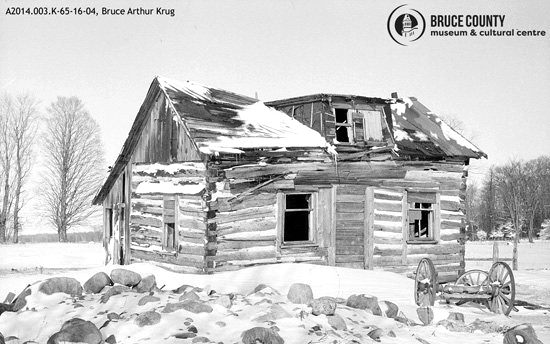When you wake up and your bed is covered in snow, you know it’s winter.
And time to get out the long underwear.
The pioneer settlers of Bruce County found that their log shanties and cabins were not well-fitted for winter weather. Ferocious winds drove snow into every nook and cranny. Paper and rags were stuffed around the doors and windows, and heavy material, such as a quilt, was hung over the windows at night to keep the heat in and the cold out.
Here’s how Olive E. Hepburn wrote about a typical day in their cabin on Hope Bay on the Bruce Peninsula, in the 1982 Yearbook of the Bruce County Historical Society.
“On a frosty winter morning Father was first up, shaking out the ashes in the potbellied stove in the front room, and going on to the kitchen stove. He called the boys of the family to help with the stable chores. Boys did not require much time to dress, as they usually slept in their underwear and shirts for the sake of warmth. While they were dressing, Father was busy breaking the ice in the pails and filling the kettle.
“Before the men left for the barn, Mother would appear, as the fire was never left unattended. Mother called the girls to dress while she made the porridge. The girls dressed beside the heater with its little square isinglass window. They did not take off their warm flannelette nightgowns, but simply removed their arms from the sleeves and proceeded to dress as under a tent. When they whipped the nightgown off over their heads, all that was left to be done was the hair. This was unbraided, brushed and re-braided, and the day for the girls had begun.
“Children going to school on a frosty morning in midwinter had to wear the warmest of clothing. For both sexes this included long woollen underwear, two pairs of long black home-knit ribbed stockings, held up by round garters. Little girls wore dark bloomers under their serge or homespun dresses. Bloomers had elastic around the waist and legs which helped to keep out the chilly draughts. Warm coats (often made over) were worn by both boys and girls with a hand-knit toque (commonly called a tewk) on the head and a long scarf (sometimes known as a cloud) wrapped snugly around the head and throat.
“Father wore two-piece woolen underwear. The shirt pulled over the head and buttoned up the front to the neck. The drawers had two little bands of fawn-coloured ribbon through which he pulled his braces or suspenders, thus assuring safety and comfort. The day came when Father could not purchase his favourite brand, and he had to settle for the new-fangled combination style, with a fold-over flap at the seat and the same at the chest.
“Poor Father, dressing in the semi-darkness of the winter morning, guessed wrongly. He managed to put his arms in the legs and his head through the trapdoor. Although it seemed that the arms were overly long and the legs rather short (barely extending below the knee), he wore this uncomfortable garment for two days, before calling in Mother to ask, “What in the dickens is wrong with this infernal underwear?”
The last word goes to Phoebe Watson-Adams-Schihl of Dyers Bay, on the Bruce Peninsula. In the 2006 Yearbook she remembered her father as being rather strict. “Those long, cold winters when we trudged through the snowbanks to school we wore long underwear, and long black wool home-knit stockings. In the spring we would beg Pa to let us take off the winter underwear, but we were never allowed to do so until the 24th of May. Then we were so happy to discard the heavy clothing and shoes and just go barefoot. That was a joyous occasion.”



